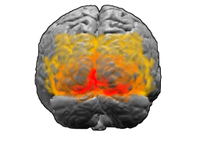
Photo from wikipedia
Mirror neurons (MNs) are a class of cells originally discovered in the monkey ventral premotor cortex (PMv) and inferior parietal lobule (IPL). They discharge during both action execution and action… Click to show full abstract
Mirror neurons (MNs) are a class of cells originally discovered in the monkey ventral premotor cortex (PMv) and inferior parietal lobule (IPL). They discharge during both action execution and action observation and appear to play a crucial role in understanding others’ actions. It has been proposed that the mirror mechanism is based on a match between the visual description of actions, encoded in temporal cortical regions, and their motor representation, provided by PMv and IPL. However, neurons responding to action observation have been recently found in other cortical regions, suggesting that the mirror mechanism relies on a wider network. Here we provide the first description of this network by injecting neural tracers into physiologically identified IPL and PMv sectors containing hand MNs. Our results show that these sectors are reciprocally connected, in line with the current view, but IPL MN sectors showed virtually no direct connection with temporal visual areas. In addition, we found that PMv and IPL MN sectors share connections with several cortical regions, including the dorsal and mesial premotor cortex, the primary motor cortex, the secondary somatosensory cortex, the mid-dorsal insula and the ventrolateral prefrontal cortex, as well as subcortical structures, such as motor and polysensory thalamic nuclei and the mid-dorsal claustrum. We propose that each of these regions constitutes a node of an “extended network”, through which information relative to ongoing movements, social context, environmental contingencies, abstract rules, and internal states can influence MN activity and contribute to several socio-cognitive functions.
Journal Title: Brain Structure and Function
Year Published: 2017
Link to full text (if available)
Share on Social Media: Sign Up to like & get
recommendations!